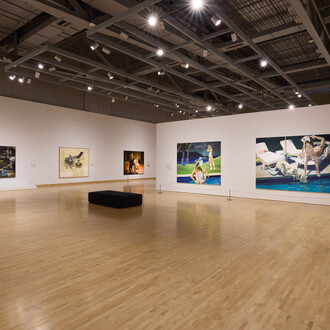¡Viva la Revolución! José Guadalupe Posada and the Taller de Gráfica Popular will showcase the work of José Guadalupe Posada (1851-1913), a pioneering printmaker who profoundly impacted the development of political critique in Mexican art, especially that of the Mexican Muralists and the group known as the Taller de Gráfica Popular (The People’s Print Workshop, or TGP).
Between 1872 and 1913, Posada produced more than 20,000 prints for newspapers, street gazettes, and broadsheets. Often referred to as the Mexican Goya, his prints were alternately satirical, humorous, or cynical. He is best known for his images of calaveras (skulls or skeletons), which reference both Mexican pre-Columbian art and popular Day of the Dead (Día de los Muertos) festivals. These skeletons began as scathing caricatures of politicians and the bourgeoisie and evolved into characters enacting the idiosyncrasies of everyday Mexican life. As Diego Rivera described his friend: “Posada was so outstanding that perhaps one day his name may be forgotten. He was so closely associated with the spirit of the Mexican people that he may end up just as an abstraction.”
Founded in Mexico City in 1937, the Taller de Gráfica Popular revived Posadas’s legacy in their own populist portrayals of everyday people and allegorical depictions of post-revolutionary ideals. Founding artists Leopoldo Méndez, Luis Arenal, Raúl Anguiano, and Pablo O’Higgins also shared the Mexican Muralists’ commitment to workers and their struggles, as well as their idealism in creating activist art. Building on Posada’s precedent, the TGP aimed to create radical yet inexpensive artworks like wood- and linoleum-block prints that were accessible to a wide audience. As they proclaimed in their declaration of principles: “The TGP believes that, in order to serve the people, art must reflect the social reality of the times and have unity in content and form.”
The Taller’s enormous output included posters, leaflets, print portfolios—the first of which was dedicated to Posada’s works—and even bilingual postcards for tourists, like the five sets on view in this gallery. Many depict daily life, but the majority denounce the exploitation of the poor and abuses of peasant rights, the unequal system of land ownership, United States imperialism, and European fascism. The sale of such postcards afforded the workshop international exposure and acclaim. Additional revenue from art classes for foreign students also enabled the TGP to offer art courses open to Mexican applicants from all social classes. In their heyday of the late-1930s and 1940s, the Taller truly became a workshop of and for the people—just as Posada had become the people’s printmaker three decades before.














